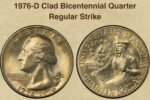she found a rare 2 bill in her wallet : When Vanessa Mitchell, a 31-year-old from Des Moines, Iowa, reached into her wallet to pay for her morning coffee, she had no idea that a simple $2 bill would turn into a life-changing discovery. Tucked between ordinary bills, the note seemed unremarkable at first glance. But when the cashier—a hobbyist currency collector—noticed its red seal, everything changed.
After getting the bill appraised, Vanessa learned it was a rare 1928 United States Note in pristine condition, valued at an astonishing $4,500. Her story quickly went viral, reigniting public fascination with the often-overlooked $2 bill. Surprisingly, her experience isn’t unique—across the country, people are uncovering rare and valuable $2 bills in everyday transactions.
What Makes a $2 Bill Valuable?
Not all $2 bills are worth more than their face value, but certain features can turn them into highly sought-after collectibles. Key factors include the year of issue, seal color, serial number, condition, and printing errors. Older bills, particularly those from 1928 or earlier, tend to be the most valuable, especially if they have red or brown seals instead of the standard green.
Unique serial numbers—such as low digits, repeating patterns, or star notes (replacement bills marked with a star)—can significantly increase a bill’s worth. Additionally, misprints, like off-center designs or missing ink, make certain bills even rarer. For collectors, crisp, uncirculated condition is ideal, as wear and tear diminish value.
A Brief History of the $2 Bill
The $2 bill has a storied — and sometimes you might say “wallet-storied” — history in U.S. currency. It was first used in 1862, when Alexander Hamilton was on the bill; that was replaced with Thomas Jefferson in 1869. The bill was completely redesigned back in 1928, when it was made the same size as modern currency.
Its reverse side had Monticello, the Thomas Jefferson estate for decades, until, shortly before the 1976 Bicentennial edition, it was replaced with an image of the Declaration of Independence. $2 bills, while still printed today, aren’t exactly common currency, causing many people to believe they’re out of circulation.
How to Check If Your $2 Bill Is Valuable
Don’t spend that $2 bill quite so fast — you may find it’s worth a lot more than its face value. Begin by looking at the series year; bills dated before 1963 that have red seals are especially sought after. Then scrutinise the serial number for serial number ‘consecutives’ or the star symbol – indicating a replacement note.
If the bill seems misprint ed — such as ink that shifted or missing elements — it might be an error note. Finally take a look at its condition: A fresh, unopened bill in mint condition will always command the highest prices. For a professional opinion, take it to a certified currency dealer or grading service such as PMG (Paper Money Guaranty).
The Growing Market for Rare Currency
In recent years, the collectible currency market has surged, driven by social media trends and online auctions. Platforms like TikTok and YouTube have popularized rare bill discoveries, while auction sites like eBay and Heritage Auctions report record-breaking sales for high-grade $2 bills.
According to the Professional Currency Dealers Association (PCDA), the market has grown by over 40% since 2023, with rare notes becoming both historical artifacts and investment assets. Collectors are especially drawn to bills with unique serial numbers, printing errors, or historical significance.
Common Myths About $2 Bills
“They’re more popular than ever, but there are still a lot of myths around $2 bills.” Then one common myth about them is that they’re no longer produced—which, in fact, is not the case: The U.S. Treasury continues to churn them out in small runs. Another false impression is that all old $2 bills are valuable; not so, as only certain series and characteristics are worth high prices.
Also, others seem to think they can’t be spent, but you can use them as legal tender for any purchase. Even today, $2 bills can be collectible, especially if they possess rare serial numbers or printing oddities.
How to Sell a Rare $2 Bill
If you believe you’ve found a valuable $2 bill, follow these steps before selling:
- Preserve its condition—Avoid folding or writing on it, and store it in a protective sleeve.
- Get an appraisal—Consult a reputable currency dealer or grading service for an accurate valuation.
- Research comparable sales—Check auction sites to see what similar bills have sold for.
- Choose a trusted selling platform—Use established auction houses, online marketplaces, or numismatic clubs to ensure a fair and secure transaction.
Final Thoughts
The story of Vanessa Mitchell is a stern reminder that undiscovered treasures sometimes come from the unlikeliest of places. If you have a keen eye, or even if you’re just passingly curious, examining the coins rattling around in your spare change could lead to an interesting discovery. In a market where rare currency is stronger than ever, that neglected $2 bill in your pocket could be a stroke of luck.
FAQs
Q1: Are all $2 bills valuable?
No, most modern $2 bills are worth face value unless they have rare features like star notes, misprints, or unique serial numbers.
Q2: What does a red seal mean on a $2 bill?
A red seal indicates it’s a United States Note (issued before 1963), which is rarer and often more valuable than standard Federal Reserve Notes.
Q3: What is a star note?
A star note is a replacement bill marked with a star in the serial number, printed to replace misprinted originals. These are often more collectible.
Q4: Where can I check the value of my $2 bill?
Consult currency appraisal guides, professional dealers, or auction sites like eBay and Heritage Auctions for recent sales data.
Q5: Is it safe to sell rare bills online?
Yes, but use trusted platforms, provide clear photos, and consider insured shipping to protect your sale.



